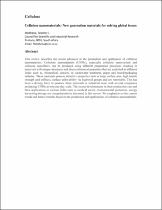JavaScript is disabled for your browser. Some features of this site may not work without it.
- ResearchSpace
- →
- Research Publications/Outputs
- →
- Journal Articles
- →
- View Item
| dc.contributor.author |
Mokhena, Teboho C

|
|
| dc.contributor.author |
John, Maya J

|
|
| dc.date.accessioned | 2021-03-10T10:37:42Z | |
| dc.date.available | 2021-03-10T10:37:42Z | |
| dc.date.issued | 2020-02 | |
| dc.identifier.citation | Mokhena, T.C. & John, M.J. 2020. Cellulose nanomaterials: New generation materials for solving global issues. <i>Cellulose, 27.</i> http://hdl.handle.net/10204/11881 | en_ZA |
| dc.identifier.issn | 0969-0239 | |
| dc.identifier.issn | 1572-882X | |
| dc.identifier.uri | http://hdl.handle.net/10204/11881 | |
| dc.description.abstract | This review describes the recent advances in the production and application of cellulose nanomaterials. Cellulose nanomaterials (CNMs), especially cellulose nanocrystals and cellulose nanofibers, can be produced using different preparation processes resulting in materials with unique structures and physicochemical properties that are exploited in different fields such as, biomedical, sensors, in wastewater treatment, paper and board/packaging industry. These materials possess attractive properties such as large surface area, high tensile strength and stiffness, surface tailor-ability via hydroxyl groups and are renewable. This has been a driving force to produce these materials in industrial scale with several companies producing CNMs at tons-per-day scale. The recent developments in their production rate and their applications in various fields such as medical sector, environmental protection, energy harvesting/storage are comprehensively discussed in this review. We emphasize on the current trends and future remarks based on the production and applications of cellulose nanomaterials. | en_US |
| dc.format | Fulltext | en_US |
| dc.language.iso | en | en_US |
| dc.relation.uri | https://doi.org/10.1007/s10570-019-02889-w | en_US |
| dc.relation.uri | https://link.springer.com/article/10.1007/s10570-019-02889-w | en_US |
| dc.source | Cellulose, 27 | en_US |
| dc.subject | Cellulose nanomaterials | en_US |
| dc.subject | Nanomaterials | en_US |
| dc.title | Cellulose nanomaterials: New generation materials for solving global issues | en_US |
| dc.type | Article | en_US |
| dc.description.pages | 1149-1194 | en_US |
| dc.description.note | Due to copyright restrictions, the attached PDF file contains the abstract of the full-text item. For access to the full-text item, please consult the publisher's website: https://doi.org/10.1007/s10570-019-02889-w. | en_US |
| dc.description.cluster | Chemicals | en_US |
| dc.description.impactarea | Advanced Polymer Composites | en_US |
| dc.identifier.apacitation | Mokhena, T. C., & John, M. J. (2020). Cellulose nanomaterials: New generation materials for solving global issues. <i>Cellulose, 27</i>, http://hdl.handle.net/10204/11881 | en_ZA |
| dc.identifier.chicagocitation | Mokhena, Teboho C, and Maya J John "Cellulose nanomaterials: New generation materials for solving global issues." <i>Cellulose, 27</i> (2020) http://hdl.handle.net/10204/11881 | en_ZA |
| dc.identifier.vancouvercitation | Mokhena TC, John MJ. Cellulose nanomaterials: New generation materials for solving global issues. Cellulose, 27. 2020; http://hdl.handle.net/10204/11881. | en_ZA |
| dc.identifier.ris | TY - Article AU - Mokhena, Teboho C AU - John, Maya J AB - This review describes the recent advances in the production and application of cellulose nanomaterials. Cellulose nanomaterials (CNMs), especially cellulose nanocrystals and cellulose nanofibers, can be produced using different preparation processes resulting in materials with unique structures and physicochemical properties that are exploited in different fields such as, biomedical, sensors, in wastewater treatment, paper and board/packaging industry. These materials possess attractive properties such as large surface area, high tensile strength and stiffness, surface tailor-ability via hydroxyl groups and are renewable. This has been a driving force to produce these materials in industrial scale with several companies producing CNMs at tons-per-day scale. The recent developments in their production rate and their applications in various fields such as medical sector, environmental protection, energy harvesting/storage are comprehensively discussed in this review. We emphasize on the current trends and future remarks based on the production and applications of cellulose nanomaterials. DA - 2020-02 DB - ResearchSpace DP - CSIR J1 - Cellulose, 27 KW - Cellulose nanomaterials KW - Nanomaterials LK - https://researchspace.csir.co.za PY - 2020 SM - 0969-0239 SM - 1572-882X T1 - Cellulose nanomaterials: New generation materials for solving global issues TI - Cellulose nanomaterials: New generation materials for solving global issues UR - http://hdl.handle.net/10204/11881 ER - | en_ZA |
| dc.identifier.worklist | 24344 | en_US |






